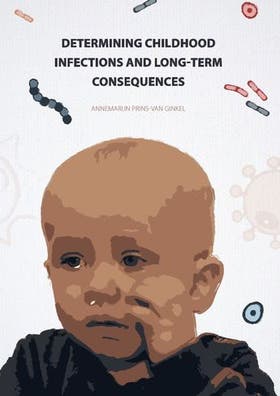Annemarijn Prins- van Ginkel
Determining childhood infections and long-term consequences

- Datum
- (Co) promotoren
- 16-04-2019
- prof.dr.ir. H.A. Smit, prof.dr. M. van der Sande, dr. P.C.J.L. Bruijning-Verhagen, dr. W. van der Hoek
Samenvatting
Infectious diseases are common in childhood and are the most important reason for physician consultations in children. An increasing body of evidence suggests that early childhood infections might also be associated with negative long-term health effects, in particular overweight and atherosclerosis. This thesis describes research on different measures of childhood infections in relation to risk factors and long-term consequences. Chapter 1 gives a general introduction about common childhood infections. In chapter 2, we investigated whether the antibody levels against Streptococcus pneumoniae and the determinants of these antibody levels changed over time before the pneumococcal conjugate vaccine was introduced in the Netherlands. The antibody levels were significantly different for nine out of the thirteen investigated pneumococcal serotypes. For children, the most important determinants for higher pneumococcal antibody levels were related to crowding, such as household size and day care attendance, and this did not change over time. In chapter 3, we investigated the incidence and modifiable risk factors of parent-reported acute otitis media (AOM) symptom episodes during infancy.The observed AOM incidence was higher than observed in studies that used healthcare data. Day care attendance was the most important modifiable risk factor. In chapter 4, we performed a proof-of-concept validation study of an interactive mobile app for monitoring occurrence of acute infectious disease episodes by investigating participant compliance and app performance in detecting and ascertaining AOM symptom episodes with this novel tool compared with traditional paper questionnaires. The proportions of completed questionnaires and the incidence of AOM symptom episodes were higher when the diary app was used than when a paper questionnaire was used. This indicates the potential benefits of using a diary app instead of paper questionnaires for reporting infectious disease episodes in children. In chapter 5, we investigated the association between different measures of childhood infections (namely frequency of general practitioner (GP) diagnosed infections, antibiotic prescriptions, and parent-reported infections), and intima media thickness of the common carotid artery (CIMT) in adolescence. The results indicated that overall, there was no association between childhood infections and CIMT in adolescence, although the data suggested that in a subgroup of participants with low socioeconomic status a higher frequency of more severe infections was associated with increased CIMT. In chapter 6, we investigated the association between different measures of childhood infections and body mass index (BMI) z-score in adolescence. The BMI z-score increased with an increasing frequency of childhood infections, although statistical significance was only observed for parent-reported infections. This indicates that the frequency of childhood infections, rather than the severity of infections, is associated with BMI in adolescence. Chapter 7 discusses the most important findings from this thesis by exploring three overarching questions. The first question was whether it is likely that common childhood infections are associated with long-term negative health effects. It was concluded that this thesis has strengthened the evidence that common childhood infections, even when mild, can be associated with long-term negative health effects. The second question was: which measure of childhood infections is most useful for the investigation of potential long-term negative health effects and how can these infections be assessed? It was concluded that the preferred measure for the investigation of potential negative long-term health effects would be prospectively recorded parent-reported symptoms of childhood infectious diseases collected via a mobile device app. The third question was about the public health implications of the findings. It was concluded that common childhood infections may have a relevant contribution to overweight and cardiovascular disease on the population level. In conclusion, common childhood infections, apart from a direct disease burden, could have important implications for long-term health in substantial proportions of the population.
